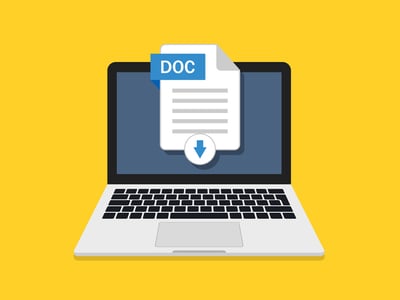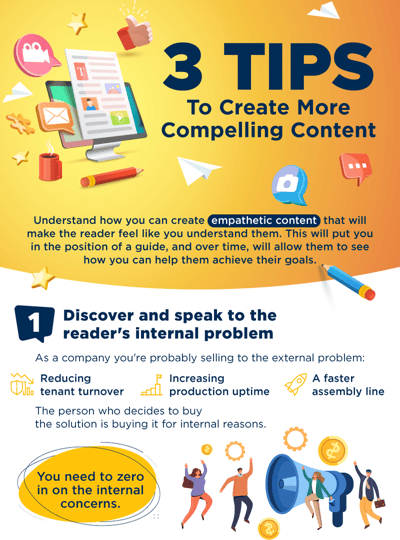 A successful content strategy must employ a mix of content in order to reach prospective customers. That’s for a few reasons:
A successful content strategy must employ a mix of content in order to reach prospective customers. That’s for a few reasons:
-
People learn differently and content in a variety of mediums lets them choose the ones they prefer. This also ties into communication style, since some prospects would rather consume some quick, higher-level content, while others really want to dig in into something meatier.
-
Prospects are in different stages of their journey, so you need a mix of content that allows them to find what they need to feel comfortable getting them to the next stage.
-
You’re likely targeting different personas, and they are often going to be interested in different topics—or at least, in different aspects of topics.
-
Websites and the various social media platforms lend themselves to different audiences and, consequently, different types of content.
Whew! That’s a lot to consider when creating a content strategy. But wait—there’s more! You also need to consider your mix of “regular” content (e.g., blogs, etc) versus “premium” content.
When clients start working with us, the biggest content gap they have tends to be premium content. That stands to reason since premium content is a heavier lift. But why is filling a gap here so important?
Let’s dig in, shall we?
What is premium content?
First, let’s make sure that we’re all working with the same definition. Premium content is longer and more in-depth than other content. As a result, it tends to demand more focused concentration than your average blog post. That’s why these pieces are often downloadable and not meant to be consumed all in one sitting. They are usually aimed at people further along the prospect journey.
Why is premium content important to include in your content strategy?
Once you have a certain number of blogs, short videos, and other content on your site, it’s time to provide some more in-depth content in order to facilitate a prospect’s customer journey. And, while you should be writing blogs that communicate what really sets your company apart, premium pieces give you an unequaled opportunity to lay out your unique perspective on your industry. While no one is going to read one premium piece and decide to buy your product, this content is a valuable sales tool that helps foster a relationship.
These longer and/or more informative pieces are also ways to build email lists and generate leads. Since these offer more value, prospects are often willing to supply their email address in exchange for knowledge. You don’t always have to gate premium content, especially when you have a lot of it, but gating it is the norm.
Premium content can feel overwhelming because, as I mentioned earlier, it’s a heavier lift. That can be paralyzing because you don’t want to invest an effort and have it be a dud. Just remember that every piece is a learning experience and, if you’re not seeing engagement, you may simply need to promote your piece better, perhaps via social, executives’ social media accounts, or paid promotion. And, in this digital age, don’t forget that you can always revise it!
So, now that we’ve covered all that, you may be wondering…
What are the types of premium content?
There are many, many types of premium content but these are the ones I’ve found most valuable, both at Imagine and past jobs. If something isn’t on this list, that doesn’t mean it’s not a great option. After all, content and content platforms are constantly evolving!
One note: I am not providing lengths for any of these categories because I’m a believer that you make a piece as long as it needs to be. Dictating lengths may lead to “filler content” that doesn’t benefit anyone.
Here are the categories I view as the 12 main pieces of premium content:
1. White papers - A white paper is a researched, authoritative paper. It tends to be quite long, so it can go into greater depth. It should provide value, but it should not—as is true for all content—be a product pitch. These are probably the heaviest lift (aside from an ebook) because you do have to do research and tend to be more serious in tone. The drawback is that these are often hard to do well in a compelling fashion. Due to their nature, they tend to be boring, but they can be valuable for certain businesses, particularly in very quantitative industries.

2. Viewpoint documents - I’ll be honest; while these are similar to white papers, I prefer viewpoint docs. Since they aren’t heavily researched (or even researched at all), viewpoint documents are kind of a “white paper lite”—but that doesn’t mean they are less valuable. After all, viewpoint docs provide a point of view—even better if it’s a controversial or radically different point of view. That’s because viewpoint docs are designed to generate discussion or serve as a think piece that illuminates a new angle.
Again, you must steer clear of a product pitch, but a viewpoint document is a fantastic place to share your unique take. Why does your company take a certain stance on an issue or do things a certain way? This is the place to explain your perspective.
3. Pillar pages - Again, this is a piece of longer-form written content. It’s also a great piece for leverage as structure for your epic’s editorial calendar. That’s because pillar pages are built around topic clusters. (See Hubspot’s great longer explanation here.) That means you can use topic clusters to build a blog calendar and, subsequently, a longer pillar page that links to your blog posts for a more in-depth discussion of each topic. This is also a great way to boost SEO because you have multiple links and topic clusters incorporated into one piece.
 4. Quizzes - Everyone loves a quiz! They’re fun and engaging. However, it can be hard to do this well, especially for a B2B company. (B2C quizzes are a lot easier because most don’t mind seeing a product pushed as an answer after they’ve been asked about lipstick or backpack preferences.) If you decide to do a quiz, I would advise thinking of it more about engagement than lead generation; I absolutely hate taking a quiz, then discovering I need to supply an email to get the results. Think about questions that will be entertaining but will also give your prospect something valuable in return for their effort.
4. Quizzes - Everyone loves a quiz! They’re fun and engaging. However, it can be hard to do this well, especially for a B2B company. (B2C quizzes are a lot easier because most don’t mind seeing a product pushed as an answer after they’ve been asked about lipstick or backpack preferences.) If you decide to do a quiz, I would advise thinking of it more about engagement than lead generation; I absolutely hate taking a quiz, then discovering I need to supply an email to get the results. Think about questions that will be entertaining but will also give your prospect something valuable in return for their effort.
5. Calculators - Calculators are fantastic, particularly if your salespeople are struggling to demonstrate ROI or some other financial payoff. That said, it takes time to put together the calculations and I’m not aware of any app—but I could be wrong!—that makes calculators plug-and-play. However, it can be really valuable in terms of providing proof of how your product or service will pay off.
6. Videos - While I’m touching on some specific subcategories of video in this list, like webinars and how-tos, it’s worth putting videos as a general category. Video is booming, and if you plan to have a YouTube channel (which, I might add, is not necessary unless you can maintain it and can post consistently), you certainly need video. But there are other uses for video as well. One Imagine client likes to create a short video to organize and summarize his thoughts as a basis for a longer written piece. Then, I use it to outline the longer piece and we work from there. When it’s done, we slice up his original short video to use as a teaser for the gated, written piece.

7. Webinars - Every client is pretty terrified to do a webinar for the first time. We get it—it’s scary. But the key is sharing something that adds value and—to paraphrase Nike—just doing it. Each webinar will get stronger, plus this is an increasingly popular way to consume content. It’s also great to slice and dice to tease on multiple social platforms.
8. How-to tutorials - When I’ve worked with B2C companies, tutorials have always done really well. People love to learn new things in a relatively entertaining and easy way. While it’s often harder to make these work for B2B companies, your business may be well-suited to it. While you obviously don’t want to share trade secrets, people appreciate authorities who share their knowledge and it also helps them get to know and like your employees.
9. Tips page - Doug Davidoff, our esteemed founder, recently had the inspiration to compile short videos about his “HubSpot Power Tips” onto one website page. It’s a great example of how to use “snackable” videos that still add value. Unfortunately, it’s only accessible to Imagine customers, but you’ll have to take our word for it—it’s magnificent!
 10. Infographics - Infographics are a useful and interesting way to represent data. (HubSpot gives some excellent examples here.) People love them because they’re eye-catching, informative, and shareable. That said, a word of caution: infographics always take longer than you think they’ll take, so be sure to allow for that. In my experience, it always takes more time to track down the right data than it does for a designer to visually represent that data. So, keep that in mind when you’re planning and enlist the right people from the beginning!
10. Infographics - Infographics are a useful and interesting way to represent data. (HubSpot gives some excellent examples here.) People love them because they’re eye-catching, informative, and shareable. That said, a word of caution: infographics always take longer than you think they’ll take, so be sure to allow for that. In my experience, it always takes more time to track down the right data than it does for a designer to visually represent that data. So, keep that in mind when you’re planning and enlist the right people from the beginning!
11. Checklists - Checklists are outstanding because they almost always add value or give the prospect back some time. You can provide downloadable checklists that are step-by-step ways to tackle a solution or checklists that show how your service measures up in comparison with competitors. While the former probably provides the most prospect value, the latter is helpful because it can shorten their research cycle.
12. Case Studies - I’m a huge fan of case studies. They are a powerful tool that demonstrates what you’ve done for a client. But, that said, these can be difficult for the same reason infographics can be challenging: data. You must give some hard numbers so prospects don’t feel like your case study is all smoke and mirrors. The hardest part of this process is often finding someone who can demonstrate that your company cut costs by 15 percent. However, once you have that kind of information, the rest should be relatively easy. (And while you’re at it, go ahead and ask the client for a testimonial to put on your site! That’s not something we’re including in this list, but it’s a valuable and related content tool.)
Of course, these are just the types of premium content that I’ve found to be most valuable for Imagine’s clients. I hope it’s a useful starting point as you think about the gaps in your content calendar. Above all, don’t be afraid to experiment and test. And remember, content and promotion work hand-in-hand—but that’s another topic for another day!


